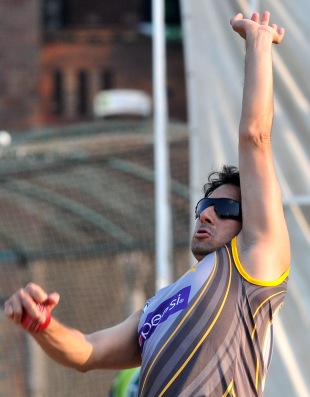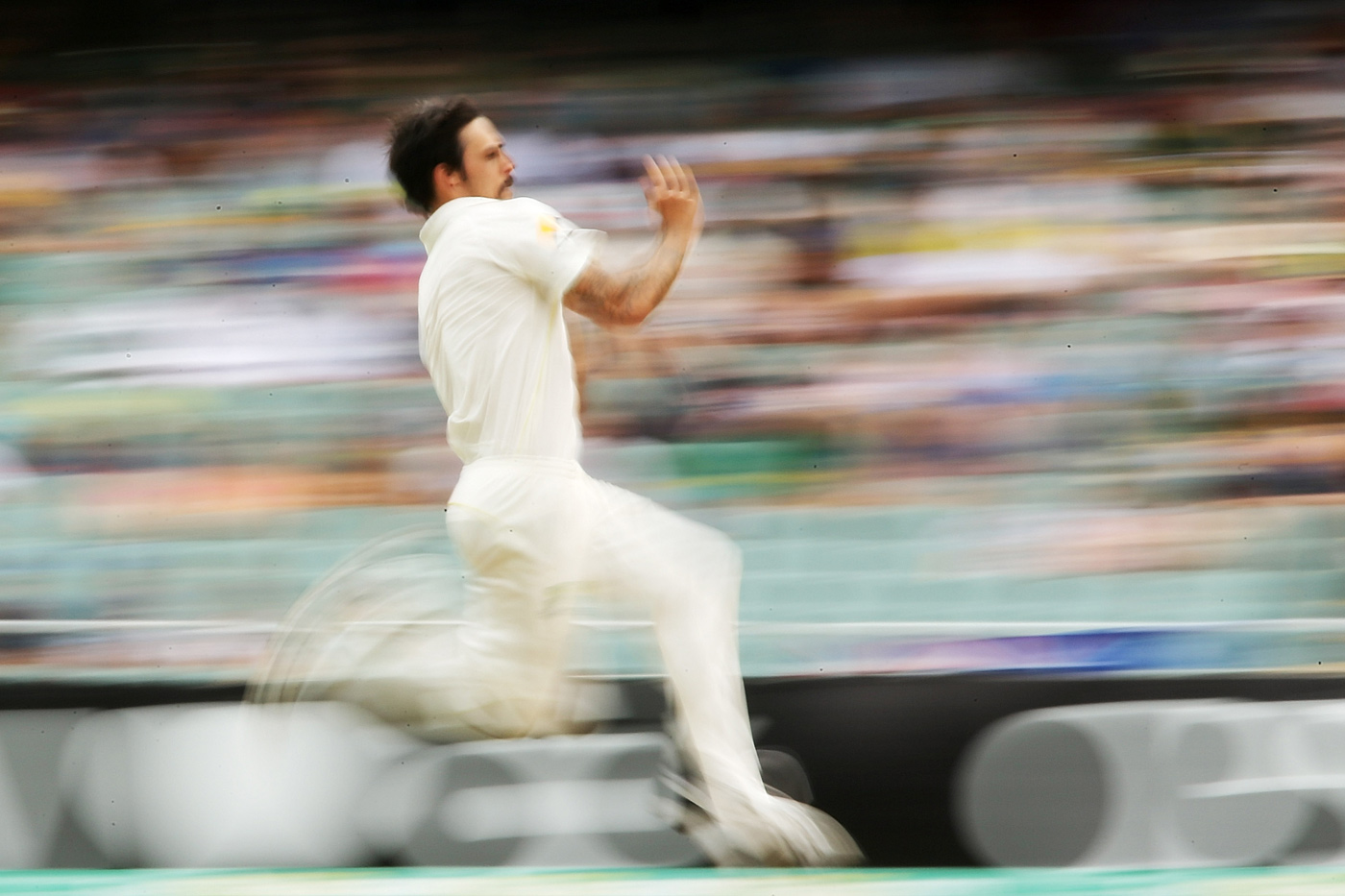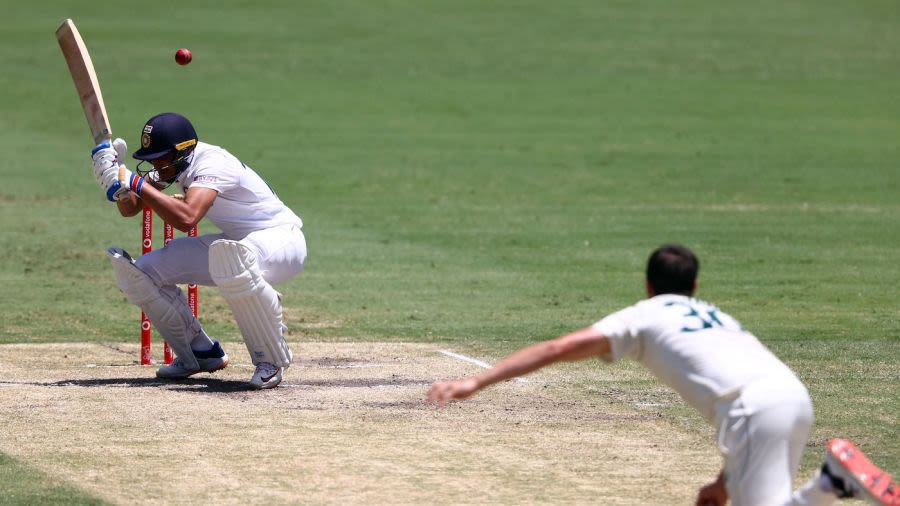
Shubman Gill ducks a Pat Cummins bouncer during India's Test tour of Australia in 2020-21 AFP/Getty Images
South Africa's Andrew Hall is on strike against Brett Lee at the Wanderers stadium in Johannesburg. The ball is bowled and Hall tucks it into the leg side before setting off for a gentle single.
As he jogs to the other end he hears a belated cheer from the crowd. Confused, he looks around to see the big screen displaying an announcement. He has just faced the fastest ball ever to have been bowled at the Wanderers.
Still confused, Hall's eyes move from the screen to Lee and they trade a quizzical look: "There's no way that was that quick."
The next ball, Lee runs in and bowls a bouncer to Gary Kirsten that flies past his face. Lee and Hall catch each other's eye once more,
"That one was."
You see, the speed gun is the movie adaptation of your favourite book. Yes, it tells the story. But it doesn't tell the full one.
****
"A lot of what makes Test players special happens before the ball comes out of a bowler's hand."
Those are the words of England analyst Nathan Leamon, speaking on Jarrod Kimber's Red Inker podcast. As a starting point, it shines a light on one of the limitations of the speed gun. It only tells us how fast a ball is at the point of release and tells us nothing about what has happened before or what happens after.
And what happens before is crucial. It is very easy to think of facing fast bowling as primarily a reactive skill. In fact, read any article on quick bowling and it will invariably say you only have 0.4 seconds to react to a 90mph delivery.
But what does that mean? No one can compute information in 0.4 seconds. It's beyond our realm of thinking in the same way that looking out of an aeroplane window doesn't give you vertigo because you're simply too high up for your brain to process it.
However, the reason it's possible is because, whilst you may only have 0.4 seconds to react, you have a lot longer than that to plan. And the best in the world plan exceptionally well.
Hall describes a training method that South Africa would use in order to be able to associate a bowler's release point with length. After a ball was bowled, they'd walk down the wicket and place a cone or mark a spot with their bat where they believed the ball had landed. The coach would confirm it or correct what the player thought.
The idea is in essence basic trigonometry. Over time, you learn to associate that if a bowler releases the ball with his arm at 12 o'clock, the delivery would be full. If he releases the ball at 1 o'clock, it would be short. It's a process designed to consciously train the subconscious, and Jacques Kallis was the best at it.
"Whether he played and missed," Hall says, "or left it, or ducked out the way, he'd be able to come down the track and isolate a rough area of where that ball had landed. And the reason he was so good at it is he became really sharp at picking up length and he made some bowlers look slower because of that. Because as they let go of the ball, he knew within a couple of inches where it was going to land."
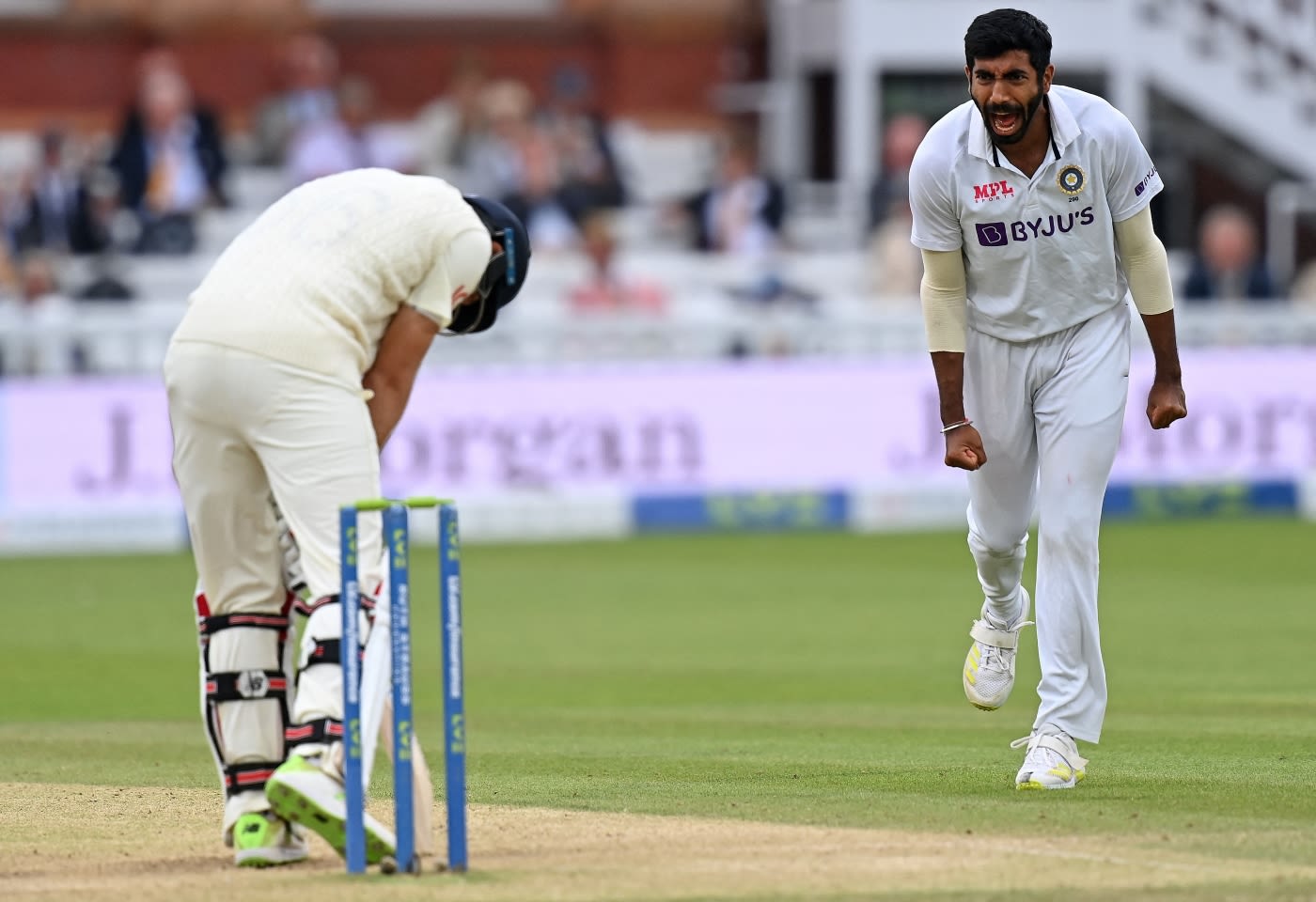 Jasprit Bumrah roars after having Joe Root caught in the slips AFP/Getty Images
Jasprit Bumrah roars after having Joe Root caught in the slips AFP/Getty Images
There are a number of pre-delivery cues that Hall, as an international player, would be looking out for. Some were obvious tells, such as a bowler running in that bit harder before bowling a bouncer; others more subtle, like a bowler's head falling away in their action so they were able to push the ball into the batter and bowl an inswinger.
These cues weren't restricted to fast bowlers either. When talking about how to face Muthiah Muralidaran, Hall explains that one of the cues the South Africans would look out for was where his right elbow would be pointing as he entered his delivery stride. If it was pointing out at 90 degrees with his hand by his ear lobe, that was the sign that Muralitharan was going to bowl his off-spinner. If his elbow was pointing down towards the batter, it was probably a doosra coming up.
"You still wouldn't be able to play it half the time," Hall adds, "but you had an idea."
And some bowlers give you more of these cues than others, meaning a bowler at 87mph may feel quicker than one at 90mph if they give the batter fewer clues in their action.
Mark Ramprakash spoke of this when comparing his experience of facing Lee and Jason Gillespie in the 2001 Ashes. Lee was the faster bowler of the two, but his textbook action, with the ball always in sight, meant that Ramprakash felt he could consistently time his pre-delivery movement. But when he faced Gillespie, despite his being slower on the speed gun, it felt quicker. And this was because Gillespie would appear almost to release the ball before he'd really landed on the ground, throwing off Ramprakash's timings. When facing Lee, Ramprakash was planning. But when he was facing Gillespie, he was reacting.
In simple terms, there's a correlation between a bowler being "different" and the feeling that they are faster than they actually are. Batters are brought up on a diet of right-arm-over bowling that is released from nigh-on the same area, ball after ball after ball. Remove that familiarity, and the feeling of speed goes up.
In the Caribbean in 2019, TV showed Jasprit Bumrah's release point was half a metre closer to the batter than Kemar Roach's. This gave Bumrah the effect of bowling 3.7mph faster than the speed gun was showing
"Take Lasith Malinga," Hall says. "If you've not faced him before, you're literally going 'what am I supposed to watch?' But you soon get told, when he gets into his action, to watch the umpire's chest and neck. If you're watching his arm, you're struggling. And that's why in the beginning he'd clean people up and they'd say 'ah, he's quick'. He's not that quick. You just couldn't follow the ball."
****
Another quirk of how we consider pace is that by measuring the speed at which a ball is released, we're not actually measuring how long it takes to reach the batter. And there's a difference.
For instance, if you set up a bowling machine at 85mph and deliver three balls in a row, one of which is a full toss, the second a good length delivery and the third a bouncer, each of the three balls will reach the other end in a different amount of time because when the ball hits the pitch, it slows down. And the steeper that impact is, the more it will slow. So counterintuitively, the bouncer, cricket's scariest delivery, is actually the slowest of the three, whereas the full toss, cricket's worst delivery, is the fastest.
But what we don't know is how different bowlers compare to each other in terms of how much pace they lose off the wicket. The information is out there, but it's just not readily available. Angus Reid from VirtualEye - the company that provides ball-tracking data for Test matches in Australia - recalls how, during Naseem Shah's Test debut for Pakistan, they did a piece for broadcast comparing how he and Australia's Pat Cummins were releasing the ball at very similar speeds, but Shah was reaching the batter faster due to a combination of his height, ball trajectory and "skiddy" nature.
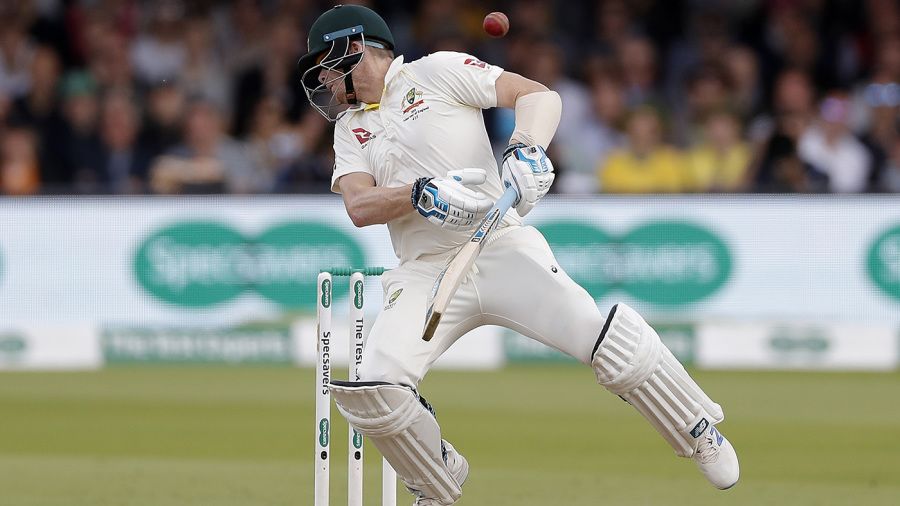 Steven Smith was pinned by a Jofra Archer bouncer at Lord's in 2019 Getty Images
Steven Smith was pinned by a Jofra Archer bouncer at Lord's in 2019 Getty Images
And we know from player anecdotes that these things matter. Hall explains how bowlers will sometimes bowl their bouncer with a cross-seam in the hope that the ball lands on the lacquer and loses less pace when it pitches. It is the same notion that Joe Root expressed earlier this year when he said India's spinner Axar Patel was beating England for pace in the pink-ball Test at Ahmedabad, because the skid off the lacquer gave the feeling that the ball was "gathering pace" off the wicket.
Conversely, many bowlers are said to bowl a "heavy ball", whereby batters feel that the ball is "hitting the bat harder" than expected. One such bowler was New Zealand bowler Iain O'Brien, who believes this was a consequence of the ball kicking up off the pitch and striking the blade higher than anticipated, due to more backspin being imparted upon release. Such was the backspin that Andrew Flintoff imparted on the ball, in the lead up to the 2005 Ashes he was accused of chucking as his wrist would snap so dramatically at the point of delivery.
This is one of the difficulties of trying to express the feeling of speed to a wider audience. For the spectator, it's merely a number because we have no other frame of reference. But for the batter, it's an experience. A moment in time that is almost over before it's begun.
One former international cricketer laughed when asked whether he would check the speed gun after facing a delivery. "Why would I need the speed gun to tell me if a ball was fast? I was the one who just faced it."
****
The final piece of the puzzle concerns the ball's release point.
When India were touring the Caribbean in 2019, TV showed an overlay of Jasprit Bumrah's release point compared to Kemar Roach's, demonstrating that Bumrah was bowling the ball half a metre closer to the batter than Roach. Some quick maths showed that this gave Bumrah the effect of bowling 3.7mph faster than the speed gun was showing. Cricket has long been played on a pitch that is 22 yards. Bumrah plays on one that is 21.5.
Admittedly, this advantage was spotted because Bumrah is on the extreme, gazillion-jointed end of the scale, enabling him to bowl closer than anyone else in a way that other bowlers can't. But given we pay attention to how wide on the crease a bowler will bowl and also how high a bowler's release point is, surely we should know how close a bowler is bowling to the batter, given it is the single easiest way of apparently increasing pace.
This effect is measured in baseball. In fact, everything is. While cricket shrugs its shoulders and says "I guess we'll never know, folks" for a myriad of data-points, every intangible detail in baseball is known and measured.
How close a pitcher releases the ball to a batter is known as "Extension" and translates to what's known as "Perceived Velocity". Famed pitching coach Tom House believes that, if you can throw the ball one foot closer to the batter, then it equals an extra 3mph for the person at the other end. Tyler Glasnow and Luis Castillo are two pitchers who both throw their fast-ball at 97mph. Glasnow's extension is one of the best in the league and Castillo's is one of the worst. As a result, Glasnow feels like he is throwing at 99mph and Castillo feels like he is throwing at 95mph.Spin rates, which could resolve cricket's heavy-ball phenomenon, are a hugely important measurement in baseball - so much so that they can now be taken into consideration in the selection process.
Even the ultimate intangible, the impact an action has on a batter before the ball has been released, is beginning to be quantified by a biomechanics company known as ProPlayAI, who have started tracking what they call a "deception metric", which measures the amount of time a batter has to see the ball in a pitcher's hand before release.
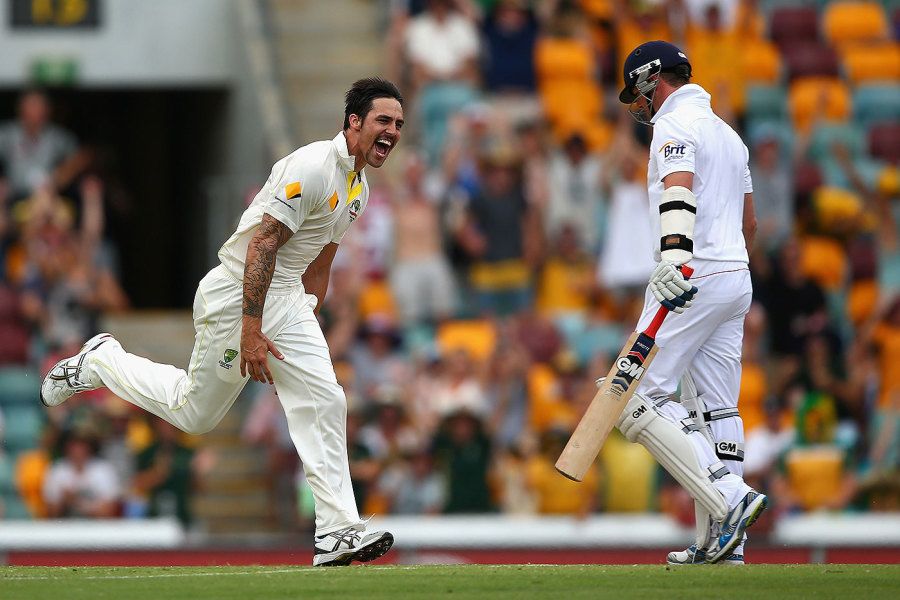 Mitchell Johnson was ferociously quick during the 2013-14 Ashes Getty Images
Mitchell Johnson was ferociously quick during the 2013-14 Ashes Getty Images
The culmination of all these factors comes in the form of a pitcher named Yusemeiro Petit, described by baseball writer Ben Lindbergh as "the poster boy for the power of deception".
Petit's average fast-ball is 87mph. A whole 7mph slower than the rest of the league. He is 37 years old and over 500 games into his career. And he has made it this far, not by being a force of nature but by representing the mystery of it. He is one of those alien fishes at the bottom of the ocean that has lived forever and we don't know why.
In the 2005 edition of the Prospect Handbook, Baseball America, which is the sport's annual guide on the young players to look out for, Petit was described as leaving "batters and scouts scratching their heads ... Nothing about it [his fast-ball] appears to be exceptional - except how hitters never seem to get a good swing against it."
Fast forward to the present day and the reasons for Petit's success are beginning to be decoded. Simply put, Lindbergh describes him as a "hider and a strider". Throwing the ball far closer to home plate than would be expected and giving the batter little to no sight of the ball in the process. The result of which is a pitcher who is far quicker than the speed gun would lead you to believe.
****
All of this isn't to say that the speed gun is useless. It isn't. But it represents different things to different people. As a broadcasting tool, it's an excellent way of telling a story in a bite-size chunk. And for a bowler, it represents the result of their process. Get everything right and watch that number go up.
For batters, however, it represents part of the process that leads to their result. Yes, the speed of a ball upon release is important. But we know that there are other factors at play, because the players at the receiving end of it say so. And ultimately, who would you rather face? A bowler that a machine says is fast? Or one that a human says feels even faster?
South Africa's Andrew Hall is on strike against Brett Lee at the Wanderers stadium in Johannesburg. The ball is bowled and Hall tucks it into the leg side before setting off for a gentle single.
As he jogs to the other end he hears a belated cheer from the crowd. Confused, he looks around to see the big screen displaying an announcement. He has just faced the fastest ball ever to have been bowled at the Wanderers.
Still confused, Hall's eyes move from the screen to Lee and they trade a quizzical look: "There's no way that was that quick."
The next ball, Lee runs in and bowls a bouncer to Gary Kirsten that flies past his face. Lee and Hall catch each other's eye once more,
"That one was."
You see, the speed gun is the movie adaptation of your favourite book. Yes, it tells the story. But it doesn't tell the full one.
****
"A lot of what makes Test players special happens before the ball comes out of a bowler's hand."
Those are the words of England analyst Nathan Leamon, speaking on Jarrod Kimber's Red Inker podcast. As a starting point, it shines a light on one of the limitations of the speed gun. It only tells us how fast a ball is at the point of release and tells us nothing about what has happened before or what happens after.
And what happens before is crucial. It is very easy to think of facing fast bowling as primarily a reactive skill. In fact, read any article on quick bowling and it will invariably say you only have 0.4 seconds to react to a 90mph delivery.
But what does that mean? No one can compute information in 0.4 seconds. It's beyond our realm of thinking in the same way that looking out of an aeroplane window doesn't give you vertigo because you're simply too high up for your brain to process it.
However, the reason it's possible is because, whilst you may only have 0.4 seconds to react, you have a lot longer than that to plan. And the best in the world plan exceptionally well.
Hall describes a training method that South Africa would use in order to be able to associate a bowler's release point with length. After a ball was bowled, they'd walk down the wicket and place a cone or mark a spot with their bat where they believed the ball had landed. The coach would confirm it or correct what the player thought.
The idea is in essence basic trigonometry. Over time, you learn to associate that if a bowler releases the ball with his arm at 12 o'clock, the delivery would be full. If he releases the ball at 1 o'clock, it would be short. It's a process designed to consciously train the subconscious, and Jacques Kallis was the best at it.
"Whether he played and missed," Hall says, "or left it, or ducked out the way, he'd be able to come down the track and isolate a rough area of where that ball had landed. And the reason he was so good at it is he became really sharp at picking up length and he made some bowlers look slower because of that. Because as they let go of the ball, he knew within a couple of inches where it was going to land."
 Jasprit Bumrah roars after having Joe Root caught in the slips AFP/Getty Images
Jasprit Bumrah roars after having Joe Root caught in the slips AFP/Getty ImagesThere are a number of pre-delivery cues that Hall, as an international player, would be looking out for. Some were obvious tells, such as a bowler running in that bit harder before bowling a bouncer; others more subtle, like a bowler's head falling away in their action so they were able to push the ball into the batter and bowl an inswinger.
These cues weren't restricted to fast bowlers either. When talking about how to face Muthiah Muralidaran, Hall explains that one of the cues the South Africans would look out for was where his right elbow would be pointing as he entered his delivery stride. If it was pointing out at 90 degrees with his hand by his ear lobe, that was the sign that Muralitharan was going to bowl his off-spinner. If his elbow was pointing down towards the batter, it was probably a doosra coming up.
"You still wouldn't be able to play it half the time," Hall adds, "but you had an idea."
And some bowlers give you more of these cues than others, meaning a bowler at 87mph may feel quicker than one at 90mph if they give the batter fewer clues in their action.
Mark Ramprakash spoke of this when comparing his experience of facing Lee and Jason Gillespie in the 2001 Ashes. Lee was the faster bowler of the two, but his textbook action, with the ball always in sight, meant that Ramprakash felt he could consistently time his pre-delivery movement. But when he faced Gillespie, despite his being slower on the speed gun, it felt quicker. And this was because Gillespie would appear almost to release the ball before he'd really landed on the ground, throwing off Ramprakash's timings. When facing Lee, Ramprakash was planning. But when he was facing Gillespie, he was reacting.
In simple terms, there's a correlation between a bowler being "different" and the feeling that they are faster than they actually are. Batters are brought up on a diet of right-arm-over bowling that is released from nigh-on the same area, ball after ball after ball. Remove that familiarity, and the feeling of speed goes up.
In the Caribbean in 2019, TV showed Jasprit Bumrah's release point was half a metre closer to the batter than Kemar Roach's. This gave Bumrah the effect of bowling 3.7mph faster than the speed gun was showing
"Take Lasith Malinga," Hall says. "If you've not faced him before, you're literally going 'what am I supposed to watch?' But you soon get told, when he gets into his action, to watch the umpire's chest and neck. If you're watching his arm, you're struggling. And that's why in the beginning he'd clean people up and they'd say 'ah, he's quick'. He's not that quick. You just couldn't follow the ball."
****
Another quirk of how we consider pace is that by measuring the speed at which a ball is released, we're not actually measuring how long it takes to reach the batter. And there's a difference.
For instance, if you set up a bowling machine at 85mph and deliver three balls in a row, one of which is a full toss, the second a good length delivery and the third a bouncer, each of the three balls will reach the other end in a different amount of time because when the ball hits the pitch, it slows down. And the steeper that impact is, the more it will slow. So counterintuitively, the bouncer, cricket's scariest delivery, is actually the slowest of the three, whereas the full toss, cricket's worst delivery, is the fastest.
But what we don't know is how different bowlers compare to each other in terms of how much pace they lose off the wicket. The information is out there, but it's just not readily available. Angus Reid from VirtualEye - the company that provides ball-tracking data for Test matches in Australia - recalls how, during Naseem Shah's Test debut for Pakistan, they did a piece for broadcast comparing how he and Australia's Pat Cummins were releasing the ball at very similar speeds, but Shah was reaching the batter faster due to a combination of his height, ball trajectory and "skiddy" nature.
 Steven Smith was pinned by a Jofra Archer bouncer at Lord's in 2019 Getty Images
Steven Smith was pinned by a Jofra Archer bouncer at Lord's in 2019 Getty ImagesAnd we know from player anecdotes that these things matter. Hall explains how bowlers will sometimes bowl their bouncer with a cross-seam in the hope that the ball lands on the lacquer and loses less pace when it pitches. It is the same notion that Joe Root expressed earlier this year when he said India's spinner Axar Patel was beating England for pace in the pink-ball Test at Ahmedabad, because the skid off the lacquer gave the feeling that the ball was "gathering pace" off the wicket.
Conversely, many bowlers are said to bowl a "heavy ball", whereby batters feel that the ball is "hitting the bat harder" than expected. One such bowler was New Zealand bowler Iain O'Brien, who believes this was a consequence of the ball kicking up off the pitch and striking the blade higher than anticipated, due to more backspin being imparted upon release. Such was the backspin that Andrew Flintoff imparted on the ball, in the lead up to the 2005 Ashes he was accused of chucking as his wrist would snap so dramatically at the point of delivery.
This is one of the difficulties of trying to express the feeling of speed to a wider audience. For the spectator, it's merely a number because we have no other frame of reference. But for the batter, it's an experience. A moment in time that is almost over before it's begun.
One former international cricketer laughed when asked whether he would check the speed gun after facing a delivery. "Why would I need the speed gun to tell me if a ball was fast? I was the one who just faced it."
****
The final piece of the puzzle concerns the ball's release point.
When India were touring the Caribbean in 2019, TV showed an overlay of Jasprit Bumrah's release point compared to Kemar Roach's, demonstrating that Bumrah was bowling the ball half a metre closer to the batter than Roach. Some quick maths showed that this gave Bumrah the effect of bowling 3.7mph faster than the speed gun was showing. Cricket has long been played on a pitch that is 22 yards. Bumrah plays on one that is 21.5.
Admittedly, this advantage was spotted because Bumrah is on the extreme, gazillion-jointed end of the scale, enabling him to bowl closer than anyone else in a way that other bowlers can't. But given we pay attention to how wide on the crease a bowler will bowl and also how high a bowler's release point is, surely we should know how close a bowler is bowling to the batter, given it is the single easiest way of apparently increasing pace.
This effect is measured in baseball. In fact, everything is. While cricket shrugs its shoulders and says "I guess we'll never know, folks" for a myriad of data-points, every intangible detail in baseball is known and measured.
How close a pitcher releases the ball to a batter is known as "Extension" and translates to what's known as "Perceived Velocity". Famed pitching coach Tom House believes that, if you can throw the ball one foot closer to the batter, then it equals an extra 3mph for the person at the other end. Tyler Glasnow and Luis Castillo are two pitchers who both throw their fast-ball at 97mph. Glasnow's extension is one of the best in the league and Castillo's is one of the worst. As a result, Glasnow feels like he is throwing at 99mph and Castillo feels like he is throwing at 95mph.Spin rates, which could resolve cricket's heavy-ball phenomenon, are a hugely important measurement in baseball - so much so that they can now be taken into consideration in the selection process.
Even the ultimate intangible, the impact an action has on a batter before the ball has been released, is beginning to be quantified by a biomechanics company known as ProPlayAI, who have started tracking what they call a "deception metric", which measures the amount of time a batter has to see the ball in a pitcher's hand before release.
 Mitchell Johnson was ferociously quick during the 2013-14 Ashes Getty Images
Mitchell Johnson was ferociously quick during the 2013-14 Ashes Getty ImagesThe culmination of all these factors comes in the form of a pitcher named Yusemeiro Petit, described by baseball writer Ben Lindbergh as "the poster boy for the power of deception".
Petit's average fast-ball is 87mph. A whole 7mph slower than the rest of the league. He is 37 years old and over 500 games into his career. And he has made it this far, not by being a force of nature but by representing the mystery of it. He is one of those alien fishes at the bottom of the ocean that has lived forever and we don't know why.
In the 2005 edition of the Prospect Handbook, Baseball America, which is the sport's annual guide on the young players to look out for, Petit was described as leaving "batters and scouts scratching their heads ... Nothing about it [his fast-ball] appears to be exceptional - except how hitters never seem to get a good swing against it."
Fast forward to the present day and the reasons for Petit's success are beginning to be decoded. Simply put, Lindbergh describes him as a "hider and a strider". Throwing the ball far closer to home plate than would be expected and giving the batter little to no sight of the ball in the process. The result of which is a pitcher who is far quicker than the speed gun would lead you to believe.
****
All of this isn't to say that the speed gun is useless. It isn't. But it represents different things to different people. As a broadcasting tool, it's an excellent way of telling a story in a bite-size chunk. And for a bowler, it represents the result of their process. Get everything right and watch that number go up.
For batters, however, it represents part of the process that leads to their result. Yes, the speed of a ball upon release is important. But we know that there are other factors at play, because the players at the receiving end of it say so. And ultimately, who would you rather face? A bowler that a machine says is fast? Or one that a human says feels even faster?

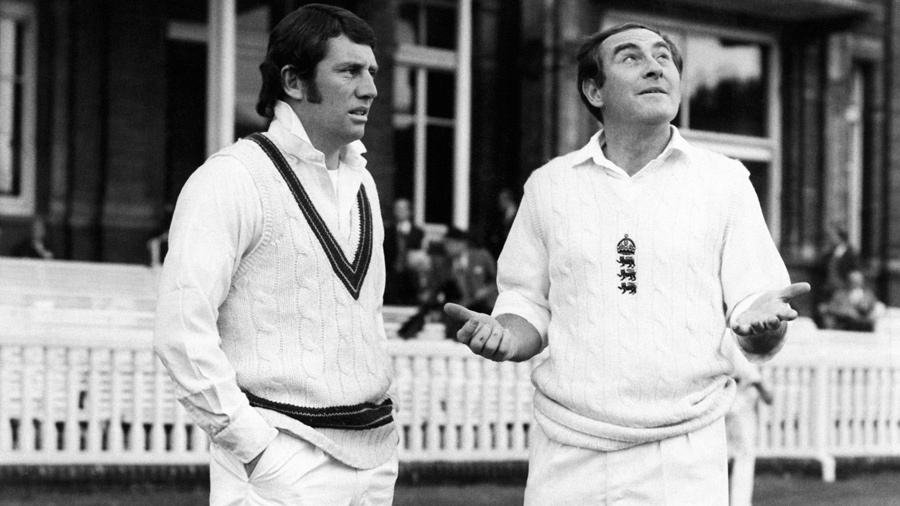
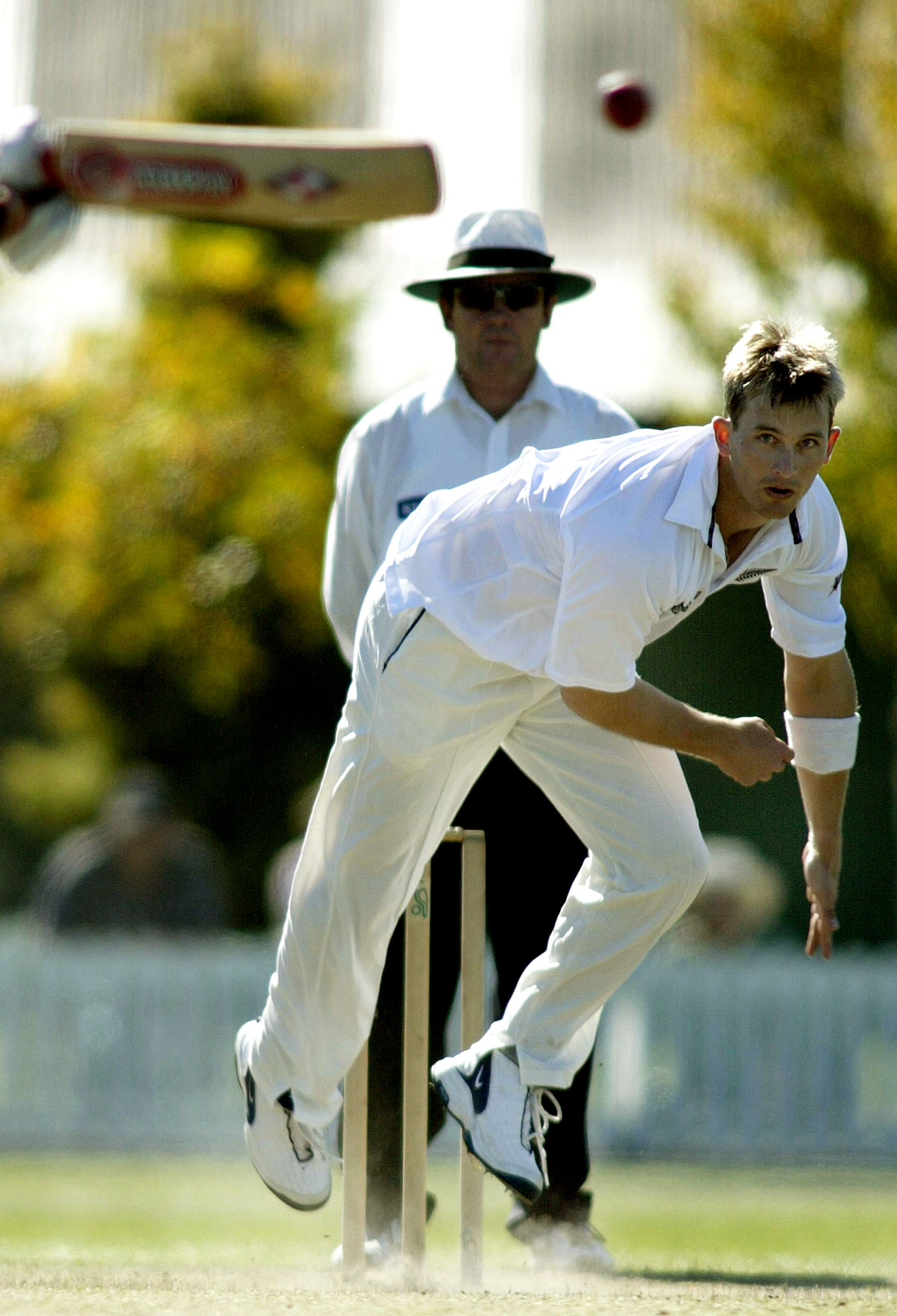 "My ability to bowl 90mph added a different sort of variety to what was already a very good bowling attack" © Getty Images
"My ability to bowl 90mph added a different sort of variety to what was already a very good bowling attack" © Getty Images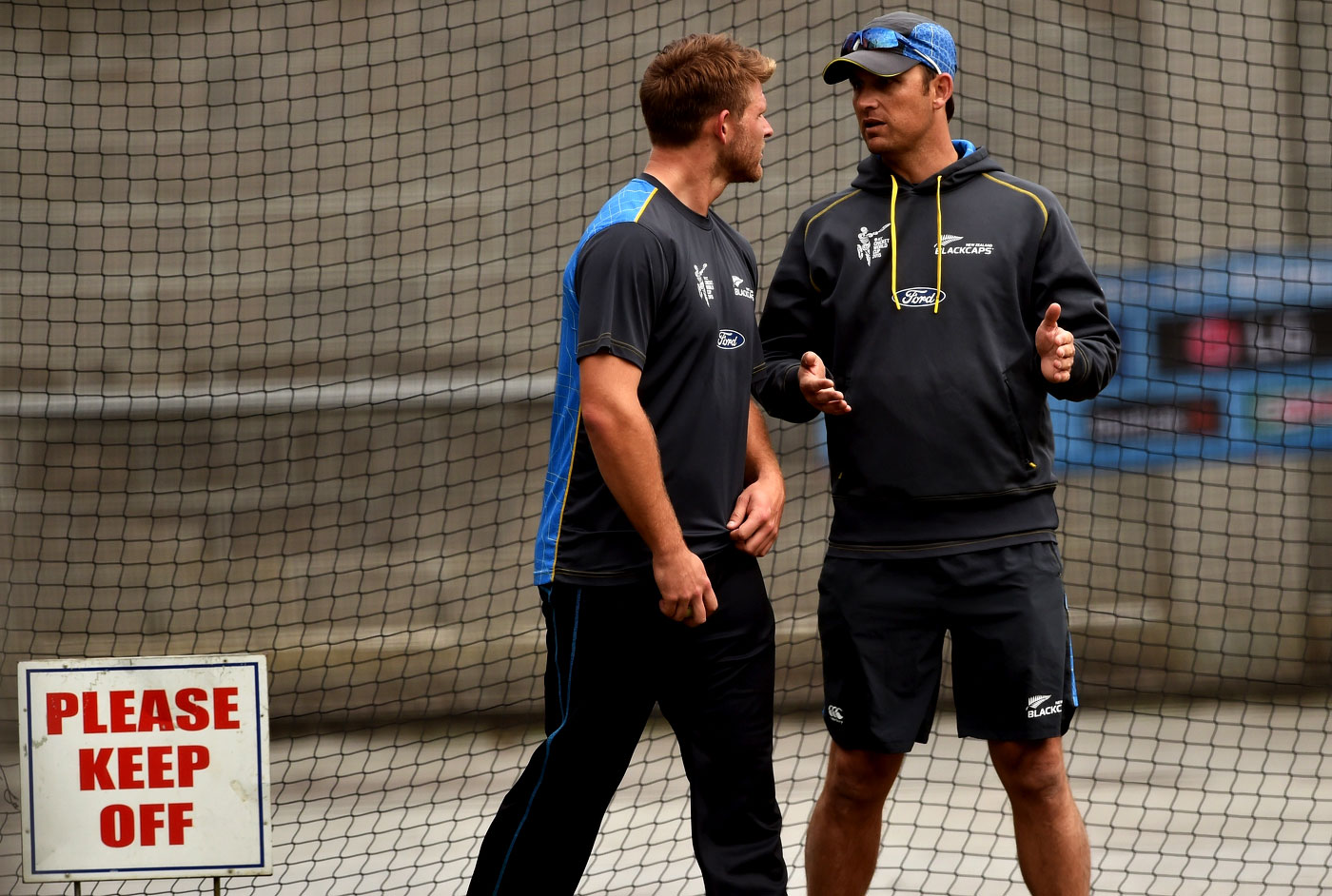 "You are always having those discussions with the bowlers: how much they are bowling, the type of bowling they are doing, rest and how they take it" © AFP
"You are always having those discussions with the bowlers: how much they are bowling, the type of bowling they are doing, rest and how they take it" © AFP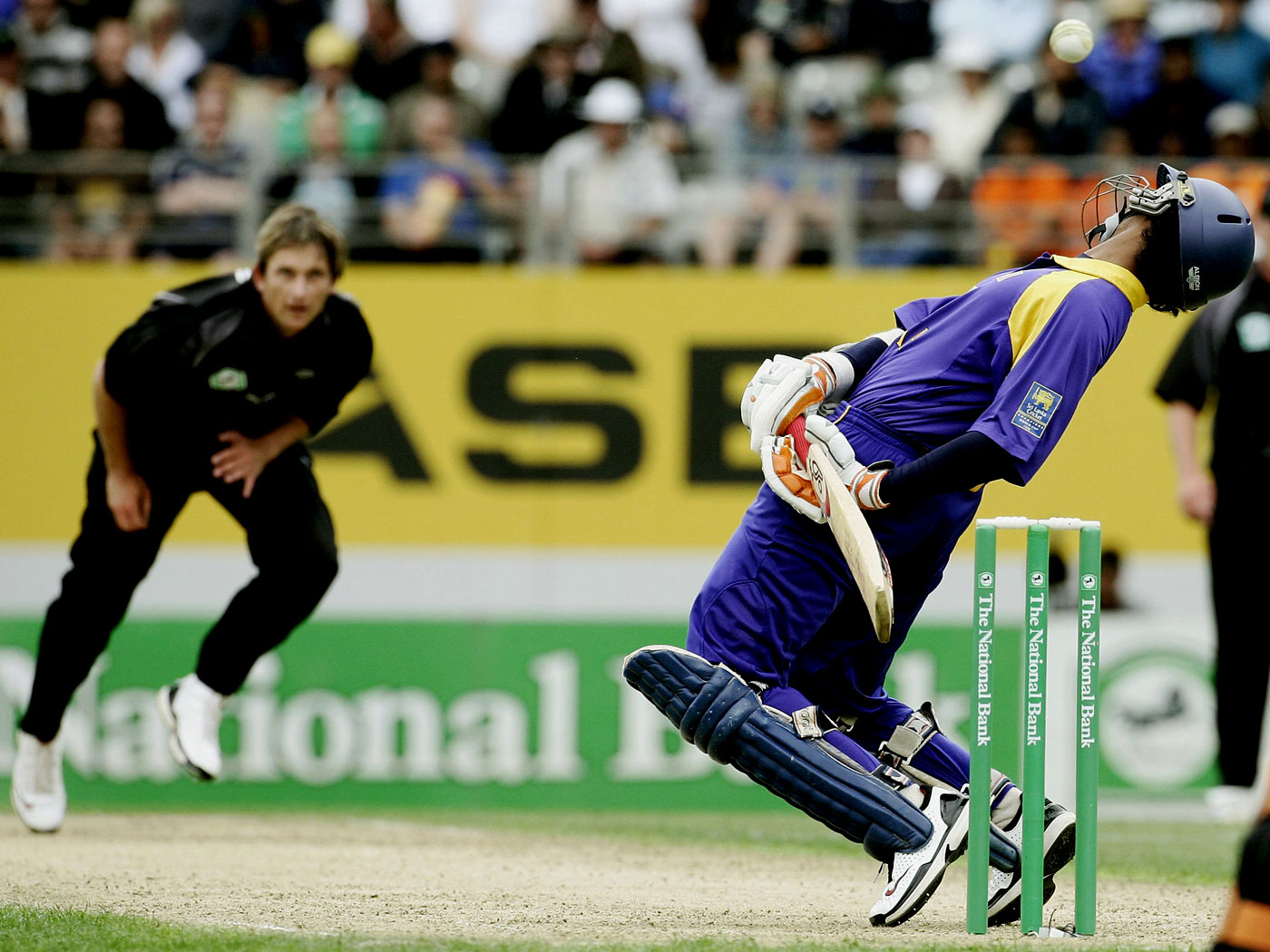 "You really need to know clearly at the back end of an ODI or T20 innings what you are going to do. That is when things can get away from a bowler" © AFP
"You really need to know clearly at the back end of an ODI or T20 innings what you are going to do. That is when things can get away from a bowler" © AFP
